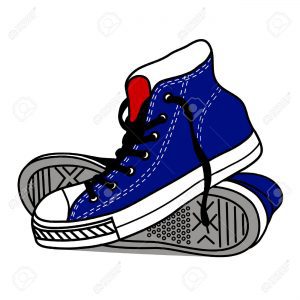Coach K recently fielded a question from an athlete about which shoes are best for workouts at the garage or at home. Learn her take on this highly personal question and why
 Shoes Make The Athlete!
Shoes Make The Athlete!
While “clothes might make the man”, read on to learn not only how shoes make the athlete, but also how to know when you need a new pair, proper fit and the best shoes for your sport or activity. First, let’s look at how to know if you need new shoes.
What Does An “Old” Shoe Look Like?
The American Academy of Podiatric Sports Medicine explains there are four parts of an athletic shoe that should be considered when a shoe may be worn out:
- Outer sole
- Midsole
- Heel Counter
- Shank or Cut out area of the shoe
When looking at the midsole, you also need to consider the following:
- “After 300-500 miles of running or walking, 45-60 hours of basketball, aerobic dance or tennis, the shoe should be replaced.”
- “There are signs of unevenness when placed on flat surface.”
- “There is noticeable creasing.”
If the heel counter “feels flexible when compressed side to side, or appears deviate to one side when viewing from the rear of the shoe”, then you probably need new shoes. Many athletes get “sticker shock” when looking at a purchase of new athletic shoes of any type. But, think of it this way: New shoes for your feet, especially if they fit correctly, are like new tires for your car. They will keep you on the road and able to compete injury free.
What Type Of Shoe Do I Need?
Good question! Of course the answer depends upon the type of activity you are doing. So, a running shoe may not be the best bet for you when you are lifting heavy weight. Conversly, a cross-training or “Oly” shoe, will probably not benefit you if you like running trails. Coach K’s advice is pretty simple for the type of workouts MissionFiT athletes do:
 The higher the heel of the shoe, the less benefit you will receive
The higher the heel of the shoe, the less benefit you will receive
Shoes come in different heel heights or “heel drop”. Heel drop means the distance between the heel of your foot when it’s in the shoe and the midsole. So, a lower heel drop equates to a flatter shoe. For instance, your typical running shoe has a higher heel to toe drop than a pair of Chuck Taylor All-Stars. So why does heel drop matter? For important reasons:
- It’s difficult to balance in a higher heel shoe
- Higher heels tend to mask bad form
As many athletes know, lack of balance and bad form can lead to injury. And no one likes to sit out a session because of injury. Watch this short video to learn the Key Differences Between Training Shoes and Running Shoes. Jake Boly also goes into What To Know Before You Buy Training Shoes. And be sure to check out the article from Jake (aka: That Fit Friend) in the video notes. Here’s a quick link: Cross-Training Shoes Vs. Running Shoes: Which Is Best For You. Take a look at the Guides at the top of the page and check out the Shoe Calculator to help you find the best shoe for you!
In addition, Coach K suggests a trip to a local Run For Your Life, Charlotte Running Company, Ultra Running or other specialized running/athletic shoe store. Bring a your current pair of running or athletic shoes with you. The folks there can watch your gait, look at your shoes and help you find the right fit. Make sure you check out the other resources below.
Resources:
- How To Find The Best Running Shoes – WedMD
- How To Select Athletic Shoes – Foot Care MD
- The CrossFit Shoes
